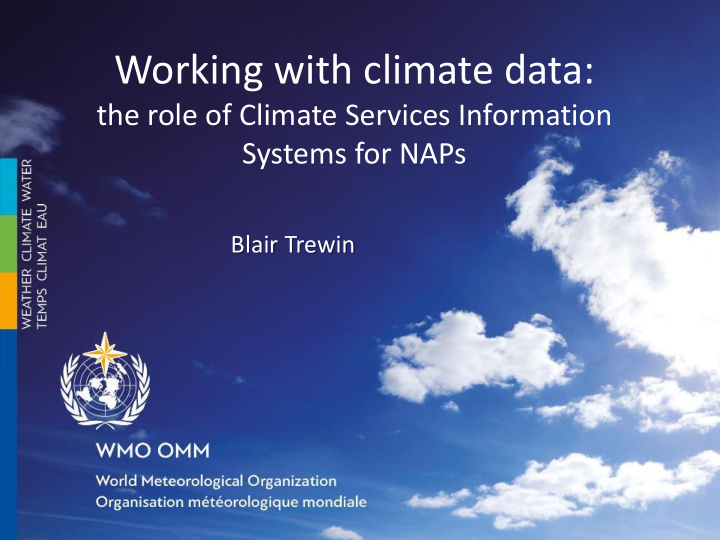



Working with climate data: the role of Climate Services Information Systems for NAPs Blair Trewin
Session outline How can CSIS What are What is the Climate be scaled up: role of CSIS Services best practices in NAPs? Information Systems (CSIS)?
A definition … Climate data is the extensive and systematic collection of a number of key variables that characterize climate over timescales
Climate Services Information System (CSIS) A seamless approach … 1 month to 1 year From 10 to 100 Time series Monitoring years 1 year to 10 years
Collecting Data Weather Forecasts Climate Models and Simulations Climate Scenarios
Global Producing and Regional Climate Centres 6
Reflection time What are the time/spatial- scales that matter to you (and to NAPs)?
Capacities underpinning data management INFRASTRUCTURAL PROCEDURAL Data management: Observational capabilities : station networks, remote sensing organize, manage and exchange data from observations, analyses platforms and models INSTITUTIONAL HUMAN Product generation: Policy use: data analysis, model runs climate information and prediction into planning, policy and practices
Data issues • Availability and digitization (data rescue) • Homogeneity (QC) • Relevance • Accessibility and communication The potential of CSIS can only be realised when the information provided matches the needs of end-users
Data rescue often the first step
Pacific Climate Change Data Portal At http://www.bom.gov.au/climate/pccsp/ - covers observed climate change
Trends in Annual Temperature (since 1961) tmean Warming at every site – stronger around PNG and the far East Pacific. Amounting to near 0.8 ° C Slightly less warming in the North tmax Pacific Warming tends to be greatest where SSTs are warming most rapidly (and rainfall increasing) tmin
Trends in Annual Rainfall 1941-2010 Since 1941 and 1961 general declines SW of the SPCZ, increases to the NE 1961-2010 1981-2010 Since 1981, declines to the NE of the SPCZ, increases to the SW
Annual Trends in Rainfall Indices 1961-2011: Consecutive dry days (days/decade) 1961-2011: Highest one day fall (mm/decade)
What CSIS can offer to NAPs • Location, timing, duration, severity of high impact weather and climate events WEATHER EXTREME INDEXES • Information on potential sectoral climate change impacts SECTOR-SPECIFIC INDEXES • A platform for initiating preparedness by different users CLIMATE OUTLOOK FORUMS • A baseline to strengthen capacities for effective climate services NATIONAL FRAMEWORKS FOR CLIMATE SERVICES
The Pacific Climate Futures tool https://www.pacificclimatefutures.net/en/
Weather and climate indicators and indexes Headline indicators • Variables or parameters used to describe weather conditions and trends (precipitation, temperature, sea surface T, GHGs, sea ice, glaciers, extremes) • Derived from physical and observational networks • Deployed for global and aggregated analysis Headline indicators will ensure consistency for the UNFCCC Global Stock-take (starting in 2023)
Weather and climate indicators and indexes Indexes of extreme events Many practical problems in policy planning require knowledge of the behavior of extreme values. Indexes: computed numerical representations of weather extremes (N° of days exceeding thresholds and departing from a normal) The WMO Expert Team on Climate Change Detection and Indexes developed 27 extremes indices
Extremes indices – 1-day rainfall
Sector specific indexes: health • Heat-stress index combines meteorological variables (T and H), with heat- budget models describing the body’s heat gains and losses • Health-warning systems: source of advice on how to avoid negative health outcomes Example of the thresholds used in the German Heat – Health Warning System (WMO, 2015) • Short-term measures: watch/warning messages • Long-term measures: public education and urban planning and design Example of the thresholds used in France – Meteo-Alarm (WMO, 2015)
Monitoring extreme events through indexes • Quantitative assessment, risk identification and management sector impacts • Cost-benefit analysis and climate-proofing • Simplify complex relationships and provide useful communication tools • Gain a uniform perspective on observed changes and support future projections of extremes
Regional climate outlook forums worldwide https://public.wmo.int/en/our-mandate/climate/regional-climate-outlook-products 22
Example seasonal climate outlook product Can do either dynamic or statistical outlook models Most Pacific systems so far are statistical Outlook for June to August 2018 (from Pacific Islands Climate Outlook Forum, https://www.pacificmet.net/products-and-services/online-climate-outlook-forum)
Useful resources http://www.wmo.int/cst /
WMO coming support to NAPs • New partnership agreements: FAO (climate & agri services), UNFCCC (Status of the Global Climate Report & GHG Monitoring), private sector engagement • Early warning services (seasonal & El Nino/La Nina bulletins) and climate and disasters briefings for UN agencies (Global Meteo-alarm) • Enhanced global greenhouse gas budget monitoring • Country databases/Pool of experts to support implementation • Guidelines on Quality Management, Capacity Building, Cataloguing of Extreme Events and Revision of Headline Indicators • Strengthening regional to national capacity development and collaboration activities
Thank you blair.trewin@bom.gov.au public.wmo.int
Recommend
More recommend